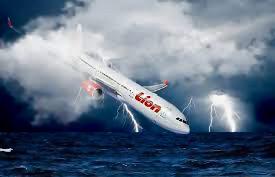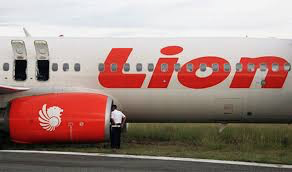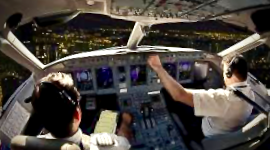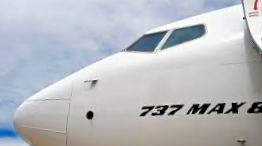Accident Update: Lion In Wait.
Accidents and Incidents (Premise).
At the Heart of a Lion (Premise).
With JT 610’s flight data recorder having been deciphered and analyzed, its cockpit voice recorder being readied for scrutiny, the various crash investigation teams have begun crossfiring around, predictably so.
At issue are facts and factors of manufacturing process, cutthroat industry competition,  technological innovation and airline pilot training. At stake is millions of dollars in causal and/or negligence liability to be paid out.
technological innovation and airline pilot training. At stake is millions of dollars in causal and/or negligence liability to be paid out.
By this time, a key question has emerged, particularly at the U.S. end of the post-crash inquiry. Namely, as aircraft technology grows ever more sophisticated and operationally complex, has the F.A.A. been too lax in overseeing the Boeing Corporation?
Circular Misfiring Squad.
Chain of descent: The aircraft manufacturing giant designed and built an advanced model of its 737 workhorse franchise. To power this expanded range and capacity single-aisle jetliner, Boeing installed larger LEAP-1B twin engines. As a result, the CFM engines require higher and more forward wing positions to prevent their bigger cowlings from hitting or dragging along taxi and runway surfaces.
Problem is, this calculated shift in weight and stress can create a destabilizing tendency for the 737 MAX 8 to nose up more than do earlier iterations, such as the 737 NG—a characteristic that can cause dangerous stalls if not precisely counteracted, especially during steep, tight turning climbs.
So as to compensate, as well as gain full F.A.A. regulatory certification, Boeing engineers devised and computer coded MCAS (maneuvering characteristics augmentation system) anti-stall software to automatically correct for that pitch-up tendency. This, by pushing the aircraft’s nose back down to normal cruise angle for the MAX’s speed and trajectory, keeping the flight in balanced trim via tail fin elevator/stabilizer controls.
Boeing initially touted the MAX 8 on bullet points of greater range and capacity, fuel savings, lower airline operating costs and technological advances. Yet the manufacturer apparently considered MCAS a relatively minor modification, and had no regulatory requirement to ‘showcase’ the system modification to airline customers. Boeing rather factored in the further cost/time savings by avoiding flight simulator training on the new technology.
Instead, pilots would just refer to existing maintenance manuals for emergency manual alternate procedures established in earlier 737 models, with a heads-up on the anti-stall flight control system  ‘annotated’ in. Hence grounding busy flight crews for costly, time consuming simulator training sessions was avoided. Even further “simplifying” involved limiting AofA (angle of attack) data readings to one fuselage nose sensor at a time. In all, Boeing opted for a streamlined information and “seamless” instruction approach. Besides, MCAS would only be actuated in the event of sudden, extraordinary circumstances, not during normal flight.
‘annotated’ in. Hence grounding busy flight crews for costly, time consuming simulator training sessions was avoided. Even further “simplifying” involved limiting AofA (angle of attack) data readings to one fuselage nose sensor at a time. In all, Boeing opted for a streamlined information and “seamless” instruction approach. Besides, MCAS would only be actuated in the event of sudden, extraordinary circumstances, not during normal flight.
Circular Arguments.
Curiously, the F.A.A. signed on to this training ‘shortcut’, and the airlines bottom line welcome it—even as the EU resisted, and Brazil, for one, required MCAS simulator training no matter what.
Then JT 610 came crashing down into the Java Sea…
At first, Boeing maintained that the Lion Air flight crew neglected to go through the MAX 8’s “checklist” of alternative procedures, including timely turning off of its stabilizer trim cutout switches, hand cranking the craft’s stabilizer wheels, pulling back on its yoke (whether or not the latter prevented stabilizer runaway), as specified in the existing operational/maintenance manuals.
But many other pilots were not buying it. They expressed alarm and anger that Boeing, the F.A.A., training centers and unions were all blameworthy in the Lion Air disaster. Pilots complained that flight crews had been left in the dark on the complex new MCAS technology, that they need to know when it is installed and activated.
Further, pilots and Indonesian authorities noted that JT 610’s data recorder reveals how Lion pilots tried frantically to pull the MAX 8 out of MCAS-directed nose downs two dozen times; that the cockpit crew could have responded to the destabilizing anti-stall system’s force more effectively with proper training.
Also claimed by probers was that neither Boeing nor the F.A.A. had previously tested MCAS technology for single AofA ‘wind dial’ sensor utilization, much less the system’s corrective processing of sensor malfunction and/or transferring of its erroneous data.
More disturbing was the finding that the Lion Air 737 crew on the doomed plane’s next-to-last flight (before JT 610) electronically logged in a variety of problems, including with the craft’s Speed Trim System—but didn’t report MCAS as the possible root of such troubles. Boeing countered that the earlier crew properly switched off stabilizer cutoffs, but then inexplicably flipped them back on—essentially breaking with its checklist protocol.
Squaring the Circle.
Although insisting that the alternate emergency stabilizer switch/wheel procedure is clearly documented in its manual and bulletins, Boeing has since modified its MCAS control law operating system with new lines of code addressing MAX 8 speed trim and stabilizer issues in a software upgrade.
For its part, the F.A.A. is reviewing MAX 8 certification, in light of the N.T.S.B. and Indonesian Civil Aviation Authority’s investigations. The agency also now stipulates that MCAS refinements and training will be scrutinized more thoroughly for MAX 8 regulatory certification going forward, as will the pilot training required for the new craft’s failsafe operation.
Whether these actions are effectively remedial or merely PR band-aids will be further determined as 610’s (recently retrieved) cockpit voice recorder’s data is analyzed and released (for one, Boeing suggesting an MCAS power throttling capacity). But watch all parties involved now drag their tails on determining and/or accepting responsibility and cause—to where new satellite data links with black boxes are unlikely to shorten this contentious, laborious process—what with millions in damages up in the air. Meanwhile, Lion announces its switch to Airbus planes.
Indeed, is it any wonder that regulators and Boeing itself are tail dragging on the necessary fixes until April at the earliest, due to engineering ‘challenges’ and differing opinions on hardware/software/pilot training upgrades? Meanwhile another Boeing craft, a 767 cargo model, has since similarly nosedived without warning into Houston’s Trinity Bay, killing a crew of three.
So Vamigré will keep eyes peeled to see if any and all further analyses and reassurances fly, and if the JT 610 saga makes resolutive headway from here—i.e., that the dodgy circle jerks make things right regarding traveler safety for a number of tragic reasons: 189 and counting. Roger that…
